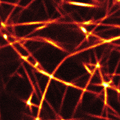Model system delivers vital clues on the aging processes of elastic polymers:
Relaxation leads to lower elasticity
01.03.2011, Press releases
Not only people suffer the ravages of time. As they age, many materials exhibit changes in their properties, as well. Although such phenomena crop up in many domains, the underlying processes are oftentimes not fully understood. Particularly interesting in this context are polymer materials found in plastics and in biological systems. A group led by physicists from the Technische Universitaet Muenchen (TUM) has succeeded in casting light on essential aspects of these processes. They present their results in Nature Materials.
Many materials, when observed over a sufficiently long period of time, show changes in their mechanical properties. The exact course of these developments depends on the underlying microscopic mechanisms. However, the microscopic structure and the complexity of the systems make direct observation extremely difficult.
That is why a team led by Professor Andreas Bausch from the Chair of Cellular Biophysics resorted to a model system that can be precisely controlled using actin filaments, a biopolymer that, among other things, is responsible for muscle contractions in the human body. Together with the crosslinking molecule fascin, actin filaments build an interconnected network whose elasticity decreases with increasing age. Deploying a wide-ranging combination of experimental techniques, the researchers have now managed to cast light on the source of these changes.
As the study published in Nature Materials shows, microscopic relaxation processes are the source of the macroscopic changes in the polymer network properties. During the formation of the network internal tensions build up. Because the linking points in the network are not of permanent nature, but rather open and close at random intervals, these tensions gradually diminish. Over a period of ten hours the elasticity drops to about a fifth of the initial value and then remains stable.
“Crosslinked and bundled actin filaments build networks that are essential for the stability of living cells,” says Andreas Bausch, head of the Chair of Cellular Biophysics at the TU Muenchen and member of the Excellence Cluster Nanosystems Initiative Munich (NIM). “By understanding the microscopic causes for the incredible mutability of the cytoskeleton, we are laying the foundations to advance the development of other polymer materials, as well.”
This research was funded by the Deutsche Forschungsgemeinschaft (Excellence Cluster Nanosystems Initiative Munich, NIM), the Deutscher Akademischer Auslandsdienst (German Academic Exchange Service), the Elite Nework of Bavaria (CompInt), the CNES and the Région Languedoc Roussillon, as well as the Institut Universitaire de France.
Original publication:
Slow dynamics and internal stress relaxation in bundled cytoskeletal networks, O. Lieleg, J. Kayser, G. Brambilla, L. Cipelletti and A. R. Bausch, Nature Materials, 10, 236–242 (2011) – DOI: 10.1038/NMAT2939
Contact:
Prof. Andreas Bausch
Technische Universitaet Muenchen
Chair of Cellular Biophysics (E 27)
James Franck Str. 1, 85748 Garching, Germany
Tel.: +49 89 289 12480 – Fax: +49 89 289 14469
E-Mail -
Internet
Kontakt: presse@tum.de
More Information
| 110301_BioPolyAlter_DE_PW.pdf |
Druckversion der Presseinformation (DE),
(Type: application/x-pdf,
Size: 111.7 kB)
Save attachment
|
|
| 110301_BioPolyAlter_EN_PW.pdf |
Printable version of the press release (EN),
(Type: application/x-pdf,
Size: 99.5 kB)
Save attachment
|




